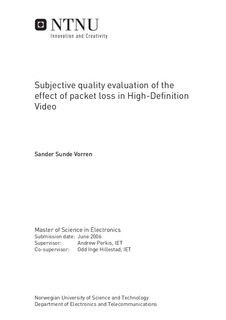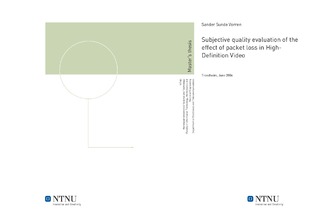| dc.description.abstract | Video streamed over packet-switched networks such as the Internet are vulnerable to packet loss, which result in a degradation of quality. This degradation can be measured subjectively or by objective measures. The Internet is a best-effort media-unaware environment where all packets receive equal quality of service (QoS), disregarding the fact that some packets are more essential in streaming multimedia applications. Using the differentiated services (DiffServ) model, unequal degrees of QoS are offered, resulting in essential packets being prioritized through the network. The main objective of this thesis is to conduct an informal subjective evaluation experiment, where the test material used consists of high-definition video distorted by various packet loss rates, using both the best effort Internet and DiffServ as underlying channel models. The results from the subjective evaluation experiment are compared to those of the objective video quality estimation to see how well the objective models perform. The video sequences are encoded by using the H.264/AVC video compression standard, and further transmitted in RTP packets. Packet loss is introduced by using a DiffServ simulator, where decoded distorted sequences are assessed. Results show that the NTIA and SSIM were the video quality models with respectively the highest and the lowest performance regarding PLCC, SRCC and RMSE. The NTIA model had statistically significant higher performance than SSIM using PLCC and SRCC with a 95% confidence interval. When comparing packet loss rate versus objective measures, the performance of best effort degrades more rapidly than the performance of DiffServ. However, the results from the subjective evaluations did not show any statistically significant differences between the two channel models using a 90% confidence interval. The DMOS values were categorized into low, medium and high packet loss rates. Studying the high (5%-10%) packet loss rate category, the DiffServ model achieved a higher mean DMOS value compared to the Best Effort model. For low (0%-2.5%) and medium (2.5%-4%) packet loss rates categories the Best Effort model achieved a higher mean DMOS value compared to the DiffServ model. | nb_NO |

